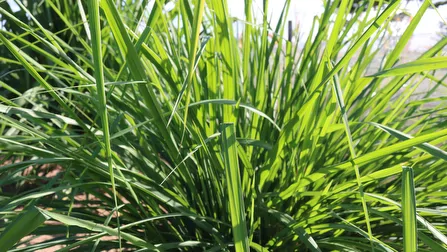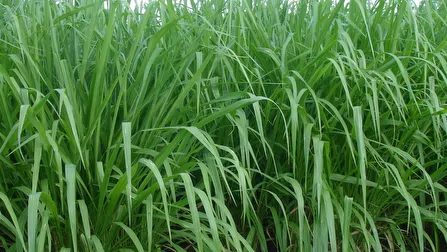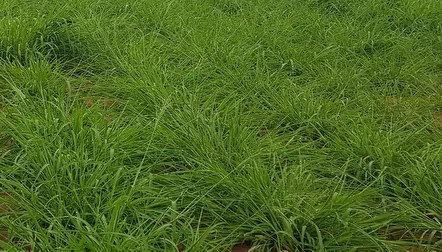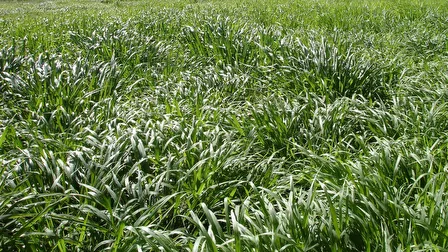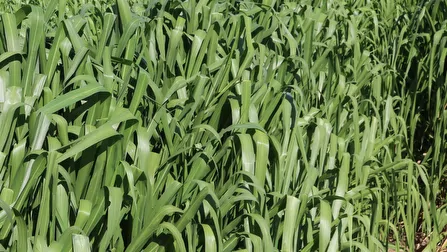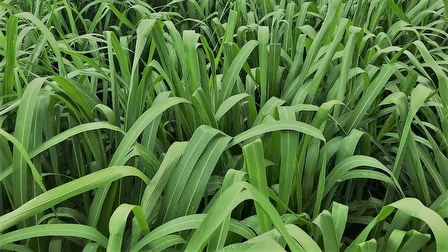
Indicação
A ruziziensis é indicada para bovinos de recria e engorda. Possui boa qualidade nutricional e boa palatabilidade, podendo ser utilizada em pastejo direto ou fenação. Devido a grande capacidade de germinação de suas sementes, principalmente em sobressemeadura em área com cultivo de outras culturas como a soja, e sobre uma cobertura vegetal, as suas sementes tem sido recomendada em áreas de plantio direto e em áreas de integração lavoura-pecuária.
Urochloa ruziziensis
Brachiaria ruziziensis
Média a alta fertilidade
Pastejo direto, fenação e cobertura de solo para plantio direto
12 a 15 t/ha/ano de matéria seca (M.S.)
8 a 11%
1,50 a 1,70m
50 a 57%
Excelente
Média
Susceptível
Boa
Perene
Utilização e Manejo
A Ruziziensis é uma forrageira indicada para solos de média a alta fertilidade. Possui boa qualidade nutricional e boa palatabilidade, podendo ser utilizada em pastejo direto ou fenação por bovinos de recria e engorda. Devido a necessidade da agricultura, de produzir de cobertura vegetal para se produzir grãos com produtividade e sustentabilidade, a ruziziensis vem sendo bastante difundida nas áreas de plantio direto e integração lavoura-pecuária. Os agricultores têm utilizado as sementes de ruziziensis em áreas de cultivo de soja para cobertura vegetal no período de entressafra da cultura e como pasto para o inverno. A forrageira proporciona excelente cobertura do solo, podendo ser utilizado a área como piquete para os animais durante o período de inverno (entressafra da cultura de soja), e em setembro-outubro as plantas de ruziziensis são dessecadas com um herbicida a base de glifosato, proporcionado uma boa cobertura vegetal para o plantio de soja novamente. Informações de produtores citam que a produção de grãos, em área de braquiárias, tem apresentado melhores rendimentos do que a produção de grãos em área exclusivamente agrícola. Entretanto, a ruziziensis deixou de ser utilizada pelos pecuaristas principalmente devido a sua susceptibilidade às cigarrinhas e a baixa capacidade de rebrota, principalmente quando superpastejada, além de sensibilidade ao pisoteio dos animais.
Origem
Esta espécie forrageira é nativa do Vale Ruzi no Zaire (Congo) e Burundi. A ruziziensis atualmente está difundida em vários países tropicais. As primeiras sementes vieram de Ruanda, que foram estudadas e disseminadas no Quênia, pelo 27 Institut National pour I’étude Agronomique du Congo Belge (INEAC) em Rubona, nos anos 60, daí se espalhou por todo o continente Africano. As primeiras sementes que foram para a Austrália (CPI 30623) em 1961 tiveram origem na ilha de Madagascar, da Estación de Agronomia de Lac Alastra, e foram lançadas com o nome comercial “ruzigrass”, no ano de 1966. Provavelmente este tenha sido o caminho percorrido pelas sementes comercializadas no Brasil, as quais vieram da Austrália.
Características Morfológicas
Gramínea perene, rasteira, atingindo até 1,5 m de altura, com rizomas curtos. Colmos decumbentes e geniculados com 3 a 4 mm de diâmetro e dotado de entrenós curtos. Folhas macias com 6 a 15 mm de largura e 10 a 25 cm de comprimento, possuindo aspecto aveludado devido a grande quantidade de pêlos nela presente. A inflorescência é uma panícula ereta de 5 a 7 racemos. Racemos curtos e com fileiras duplas de sementes, ráquilas aladas e bastante largas, tornando-se uma característica que distingue das outras espécies de braquiária. Espiguetas bifloras, sendo a inferior masculina e a superior hermafrodita.
Características Agronômicas
A ruziziensis havia desaparecido do mercado pecuário, pois se trata de uma espécie forrageira exigente em fertilidade do solo, sua alta palatabilidade dificulta o manejo, consequentemente a sua rebrota é lenta (pasto superpastejado) e as plantas são altamente susceptíveis aos ataques das cigarrinhas. Porém algumas características como hábito de crescimento prostrado, susceptibilidade ao glifosato, fizeram desta forrageira uma excelente opção para cobertura de solo para o plantio direto.
